
Home » Travel Guides » Germany » 15 Best Things to Do in Ulm (Germany)

15 Best Things to Do in Ulm (Germany)
On the Danube in Baden-Württemberg, Ulm will forever be synonymous with its epic minster. The city, also the birthplace of Albert Einstein, is a heady juxtaposition of Medieval and modern: Dating back hundreds of years are the city’s walls by the Danube and the quarter where fishermen and tanners used to live.
The half-timbered houses and traditional German restaurants on these streets clash with avant-garde new monuments to replace architecture lost in the war. And back to that minster, which soars over everything else in the city. Until the 1900s this church was in the top five tallest buildings in the world and has enough room for 20,000 worshippers.
Here are the best things to do in Ulm :
1. Ulm Minster

To set the scene, Ulm Minster has the highest steeple in the world, is officially the tallest complete church in the world and coming into the 20th century it was the 5th tallest man-made structure.
From the tower, 768 steps and 143 metres up, there’s a panorama of the Alps far in the distance to the south.
Ulm Minster was started in 1377, but partly because of its extreme dimensions was only officially completed in 1890. In the western portal take a moment to study the tympanum, filled with 14th-century carvings of scenes from the book of Genesis.
Down in the central column of the entrance is the Man of Sorrows by the Late Gothic sculptor Hans Multscher.
Don’t leave without seeing the 15th-century carved oak choir stalls, the apse’s stained glass windows from the same period and the 17th-century organ played by Mozart in 1763.
2. Fishermen’s and Tanners’ Quarter

Where the channels of the Blau Stream enter the Danube is the Medieval waterside quarter for Ulm’s tanners, fishermen and shipbuilders.
The neighbourhood reached its zenith in the 1500s when trade on the Danube was roaring.
As a testament to this high demand, the streets are tightly packed with cantilevered timber-framed houses, some so close to each other that they sometimes touch in front, like on the appropriately named Kussgasse (Kiss Alley). The quarter was also a kind of staging post for emigrants travelling down the Danube to Hungary.
They’d normally stay here for a few months to raise money before making the journey.
As you’d expect the quarter has a lot of tales to tell, and its old wooden houses are now specialty shops, bars and restaurants.
3. Schiefes Haus

What could be the cutest building in Ulm is the Schiefes Haus, a rickety inn from the start of the 15th century.
This corbelled, half-timbered house was used by Ulm’s shipmasters for hundreds of years.
At an incline of between 9 and 10° the Schiefes Haus looks like it’s just about to collapse, but is still going strong 600 years after it was built.
Adjustments have had to made over time, especially after the side facing the river started sinking in the 1600s.
According to the Guinness Book or Records it’s the most crooked hotel in the world (literally, not figuratively!). If you’d like to book a room you can rest easy knowing that your bed will at least be flat; the furniture adapts to the slope, which can be as much 40 cm in each room.
4. Museum der Brotkultur

The museum for bread culture has an apt home in a Renaissance granary that was built in 1592 and was in use until the start of the 19th century.
In 1955 the father and son Willy and Hermann Wiselen converted the warehouse into a museum about bread and its role in civilisation from prehistory to today.
You’ll delve into grain cultivation, milling, bread-making methods in different parts of the world and Medieval bakers’ guilds in Europe.
The museum has more than 18,000 objects, from ancient Europe to rice cultures in East Asia and maize cultures in Latin America.
Something that might catch you off guard is the richness of the art collection that has bread-themed works by Pieter Brueghel the Younger, Rembrandt, Max Beckmann and Picasso.
5. Wiblingen Abbey

Some way south of Ulm, near the confluence of the Iller and Danube Rivers, is a former Benedictine Abbey, now a department of the University of Ulm.
The abbey was founded in the 11th century, and in the 18th century went through a period of rejuvenation, when its buildings were redesigned in an exuberant Late Baroque style.
The biggest achievement in that period was the Rococo library on the north wing of the complex, which is spellbinding for its marble columns with gilded capitals, figurative ceiling fresco, balustrade, virtuoso stuccowork and sculptures by Dominikus Hermenegild.
6. Altes Rathaus

Coated with trompe-l’œil frescoes, Ulm’s majestic old town hall has an Early Renaissance design and is composed of three buildings, the oldest of which dates back to the 1370. The oldest architecture is on the southeast side of the complex, while the gables and daintily ornamented windows are from the 15th century.
The town hall has always been covered in murals, but by 1900 these were heavily weathered and were completely restored along the lines of the originals, depicting moment’s from Ulm’s past.
Spend a little time inspecting the astronomical clock, dating to 1520 and fitted with a mechanism by the Strasbourg master watchmaker Isaak Habrecht in 1580.
7. Ulm Town Walls

If you’re up for a restorative stroll you could make for the Danube bordered by a long remnant of Ulm’s defensive walls.
Built from brick, these date to 1482 and run from the planted Lauseck Bastion in the west for the length of the old town to the spacious Friedrichsau Park in the east.
There’s a continuous raised looking over the Danube, Ulm’s docks, the fishing quarter and the old town’s cobblestone streets.
One of the most picturesque spots is just east of the Herdbrücke, where the florid Rosengarten has lawns fringed by dozens of labelled rosebushes.
8. Metzgerturm

One unforgettable element in the defensive system by the Danube is the Metzgerturm (Butchers’ Tower), a gate predating the current line, going back to 1340. The tower got its name as an opening had to be made in the wall to make it easier to reach the city’s slaughterhouse, which was built outside the walls.
On a square plant, this structure is 36 metres tall and has a hipped roof.
But you may notice that is isn’t entirely straight.
Due to the marshy ground the tower leans two metres to the northwest; at 3.3° the slant is only slightly less severe than the Leaning Tower of Pisa (3.97°).
9. Ulmer Museum

In four adjacent houses on Ulm’s Marktplatz, the municipal museum is unmissable for its Gothic and Renaissance sculpture, but also a prehistoric statue that has no equivalent in the world.
The Lion-man was discovered in the Hohlenstein-Stadel cave in 1939 and was shaped with a flint knife from mammoth ivory between 35,000 and 40,000 years ago.
At 30 centimetres tall this is the oldest example of figurative art in the world, comprising the body of a man with the head of a lion.
For art of a more recent kind there are paintings and mesmerising works sculptures by members of the Late Gothic Ulm School, like Michel Erhart, Nicklaus Weckmann, Hans Multscher, Martin Schaffner and Jörg Stocker.
And lastly, there’s a neat collection of Expressionist works by Kirchner, Macke, Paul Klee and Franz Mac.
10. Modern Architecture

While a lot of historic buildings remain in the Fisherman’s Quarter other parts of the old centre were badly affected by bombing in 1944. Here, bold new amenities have been constructed over the last 25 years or so.
Take the Central Library, opposite the Old Town Hall and Minster, designed by Gottfried Böhm and in the shape of a glass pyramid.
The new synagogue was unveiled in 2012 close to where the original used to stand before 1938, with guided tours provided by the church office.
Two more contemporary projects, the Kunsthalle Weishaupt and the Stadthaus follow below.
11. Kunsthalle Weishaupt

That wave of architecture has given Ulm a private contemporary art museum.
The Kunsthalle Weishaupt opened in 2007 in a cube-shaped building designed by Wolfram Wöhr.
The museum is named after the entrepreneur and art patron Siegfrid Weishaupt, who has built up a notable assortment of art by the ZERO group, Lichtenstein, Warhol, Nam June Paik, Josef Albers, Yves Klein, Willem de Kooning and Keith Haring among many more.
This is shown to the public in themed exhibitions like the 10-year anniversary exhibition “Best of 10 Years”, which has highlights from the last decade (Haring, Robert Longo, Yves Klein and Max Bill) and will run until April 2018.
12. Stadthaus

Under the Minster’s sky-scraping spire is another modern addition to Ulm’s cityscape.
The gleaming white Stadthaus by New York architect Richard Meier is an attention-grabbing landmark that opened in 1993. The cavernous space inside hosts conferences, lectures, concerts and exhibitions for almost anything, from art to science.
The Stadthaus is also where you’ll find Ulm’s tourist office, as well as a restaurant that opens for breakfast.
Given the location there’s no harm stepping inside to see what’s on, and to take in the building’s daring architecture.
13. Tiergarten Ulm

Ulm’s zoo might be on the small side, but has a variety of regional and exotic animals for kids to get close to.
Best of all is the Danube aquarium, which has a glass tunnel surrounding you with the freshwater species that make their habitat in the famous river.
Also inside are terrariums for iguanas, turtles, poison dart frogs, chameleons and giant African snails.
Outside, the park’s brown bears have been a fixture at the zoo for decades and have an enormous enclosure, while there are also emus and ostriches, massive Vietnamese pot-bellied pigs and a habitat for goats that kids can walk inside.
14. Botanischer Garten der Universität Ulm

At a spacious 28 hectares, Ulm University’s botanical garden is one of the largest in the country.
The gardens are a tapestry of plant beds, meadows and forest, all laid out in 1981 on what used to a shooting range on the Obere Eselber hill to the southeast of the university.
Closer to the uni are the greenhouses for rainforest species, cactuses and Mediterranean plants.
And on trails you’ll come across a farmer’s garden with traditional crops, a herb garden, a rose garden, an arboretum, a cottage garden, an orchard and farmland where crops are rotated annually.

15. Schwörmontag

Ulm’s annual city holiday falls on the penultimate Monday of July.
The day has an administrative purpose, as it is the beginning and end of the political year in Ulm, and marks the swearing-in ceremony for the new lord mayor (“schwören” means “to swear”) . But there’s more going on than dry political procedures.
In the afternoon there’s a big bathing party in the Danube, known as the “Nabada”. Starting at 16:00 the Nabada is like a carnival on the water, with a flotilla of official themed boats and crazy home-made barges.
If Nabada falls on a warm day it will feel like the whole city (60,000 or more) has taken to the water on tubes, rafts of rowboats.
15 Best Things to Do in Ulm (Germany):
- Ulm Minster
- Fishermen's and Tanners' Quarter
- Schiefes Haus
- Museum der Brotkultur
- Wiblingen Abbey
- Altes Rathaus
- Ulm Town Walls
- Metzgerturm
- Ulmer Museum
- Modern Architecture
- Kunsthalle Weishaupt
- Tiergarten Ulm
- Botanischer Garten der Universität Ulm
- Schwörmontag
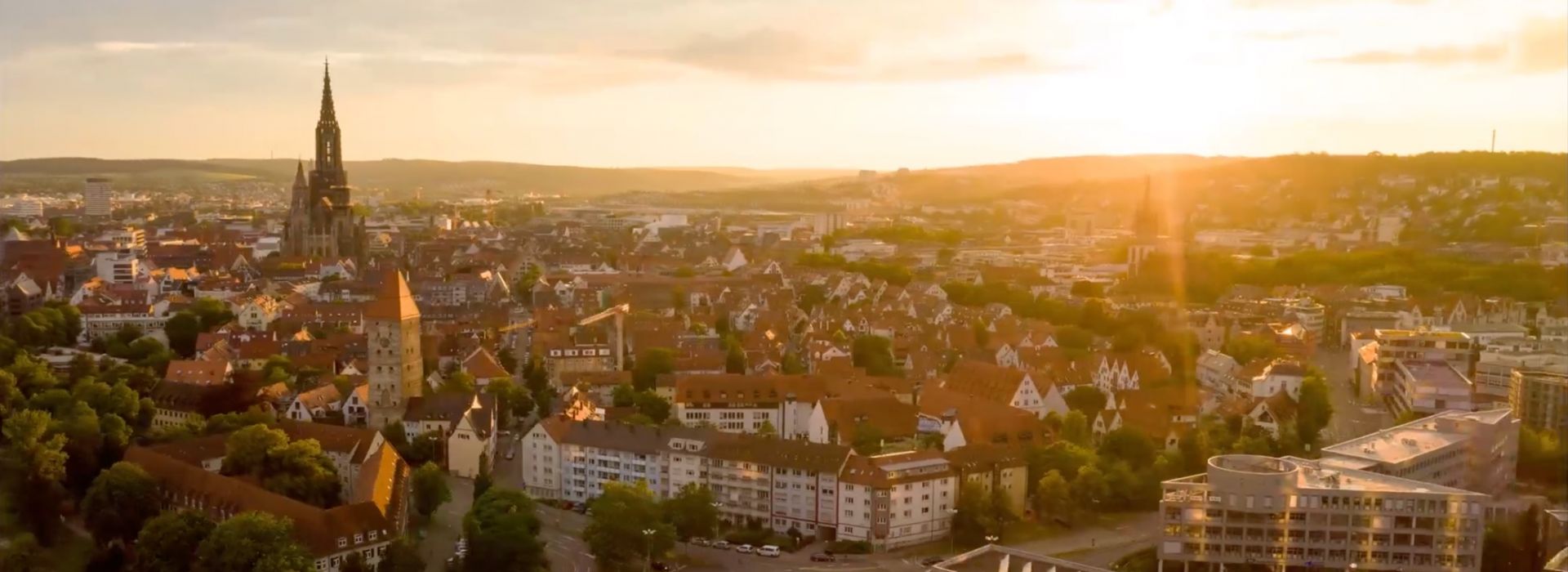
Discover Ulm/ Neu-Ulm!
Ulm & neu-ulm.
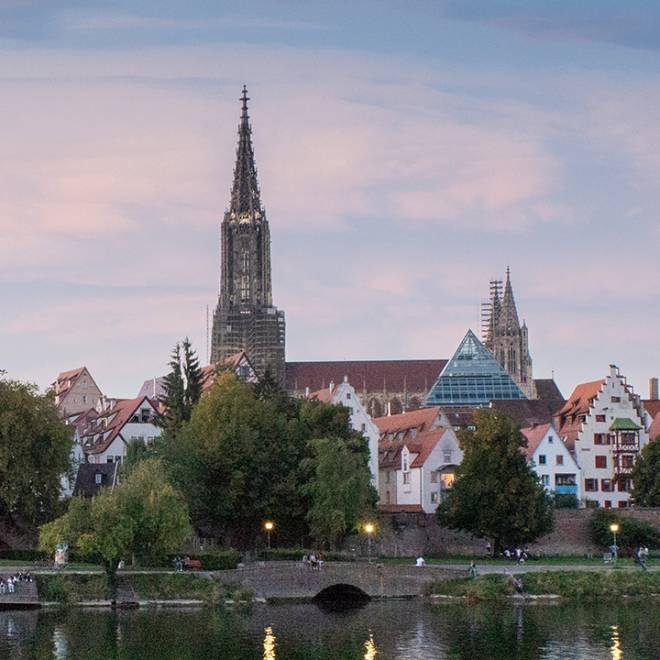
The UlmCard
Use the UlmCard for 24 or 48 hours and get the most out of your stay. Whether you're a local or a tourist.
Current Events
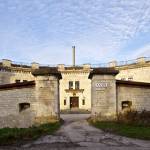
Book your stay in Ulm/Neu-Ulm right away!
The museum is located in a historic building of the Ulm Federal Fortress, only a few metres from the banks of the Danube. Two tours show the history of the Danube Swabians (950 sqm) and the diversity of the Danube, the great European river (550 sqm).
Exhibition "Danube Swabians. Departure and encounter" The Danube Swabians are the descendants of German settlers who emigrated to the then Kingdom of Hungary in the 18th century. For centuries they lived peacefully together with their neighbours - Hungarians, Romanians, Serbs, Croats and others. After the Second World War, many were uprooted by flight, expulsion, deportation and internment. They came to Germany and other countries. Those who remained in the settlement areas had to come to terms with communist regimes. The exhibition is in German, there is a German/English media guide.
Address Donauschwäbisches Zentralmuseum Schillerstraße 1 89077 Ulm
The Edwin Scharff Museum at the Petrusplatz, which opended in 1999 houses Neu-Ulm's historical collections. You can also find the most important works of Edwin Scharff here. Oil paintings, watercolours, drawings and especially sculptures trace the path from his early beginnings to his later works. Temporary exhibitions complement and enhance the permanent collection.
Scharff devoted himself to the art of the 20 th century, with views into the 19 th century and to the present day. The emphasis of the exhibitions is on the Edwin Scharff époque, i.e. the period from 1887 to 1955. In pursuing his artistic development, one aspect the museum focuses on is sculpture.
Address Edwin Scharff Museum Petrusplatz 4 89231 Neu-Ulm
Closed from August 22nd - 30th and September 3rd - 6th
The exhibition shows the most important events and topics of the history of Ulm from its beginnings to the present. Key components of the exhibitions are exhibits, models and large-scale prints and especially interactive media installations.
Address Haus der Stadtgeschichte Weinhof 12 89073 Ulm
Over more than 50 years, the entrepreneur Siegfried Weishaupt and his wife Jutta have built up a top-class collection of modern and contemporary art, which has been open to the public in the newly built private museum since November 2007.
The Weishaupt collection includes incunabula of abstract expressionism - including Mark Rothko and Willem de Kooning - as well as the work complexes of the American pop artists Warhol, Lichtenstein and Wesselmann. Josef Albers and Max Bill as representatives of concrete art as well as positions from zero and op art round off this period on the European side. Current trends in the collection reflect Robert Longo, Liam Gillick and Wolfgang Laib. On the second floor, group and individual exhibitions are presented in regularly changing constellations, drawing from the rich collection.
Address kunsthalle weishaupt Hans-und-Sophie-Scholl-Platz 1 89073 Ulm
The Museum Ulm has been under renovation since 17 April 2023 and is temporarily closed for this reason.
Until the end of the construction work, the Museum Ulm will host various exhibitions and events in the neighbouring kunsthalle weishaupt. The HfG archive on the Hochstrasse will remain open as normal.
Address Museum Ulm Marktplatz 9 89073 Ulm
Address The Walther Collection Reichenauer Straße 21 89233 Neu-Ulm
#ulmentdecken | #ulm | #neuulm
We are at your service.

Guided Tours
Check out our guided tours!

We are happy to help!

to order or download

12 Top-Rated Attractions & Things to Do in Ulm
Written by Bryan Dearsley and Barbara Radcliffe Rogers Updated Dec 22, 2023
The old German imperial city of Ulm, located on the left bank of the River Danube and founded in AD 850, is the economic and cultural center of Upper Württemberg and the starting point of the Upper Swabian Baroque Highway .
Even without its other interesting things to do, Ulm would be worth visiting for the magnificent Ulm Münster. Topped by the tallest church spire in the world - it stands at 162 meters in height - this impressive cathedral is widely regarded as one of the best preserved Gothic churches in Europe.
Tourists interested in architectural attractions will appreciate Ulm's striking blend of old and cutting-edge modern architecture, often side by side. The city is also known for its many theater, opera, and dance performances. It also boasts a first-rate professional orchestra, a large Christmas Market, and lively traditional festivals, such as Oath Monday and the Fishermen's Jousting Tournament.
Learn more about the best places to visit in this historic city, with our list of the top attractions and things to do in Ulm, Germany.
Ulm Minster
Wander the old fishermen's & tanners' quarters, explore ulm rathaus and marktplaz, walk ulm's old town walls (stadtmauer), visit museum ulm, take a side trip to wiblingen abbey, visit the museum of bread culture (museum brot und kunst), the oath house, take the kids to the tiergarten, danube swabian museum, kunsthalle weishaupt, visit ulm's einstein fountain, map of attractions & things to do in ulm.
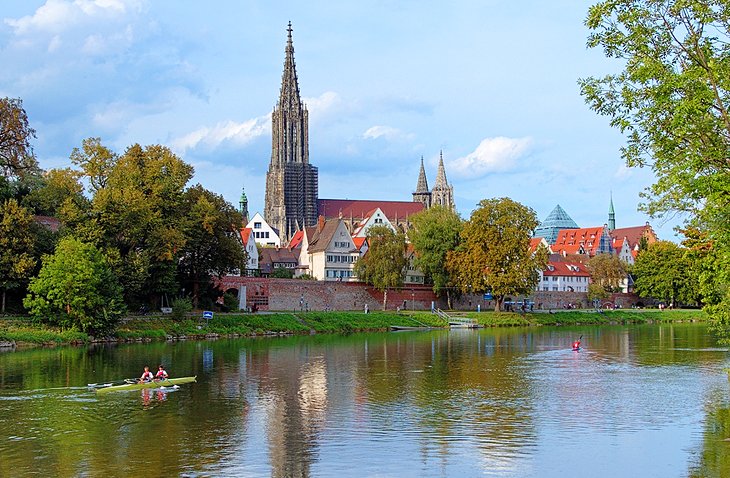
Located in the city center stands Ulm Minster (Ulmer Münster), Germany's largest Gothic church after Cologne Cathedral. Started in 1377, its soaring spire was a work in progress that began in the 14th century and was finally completed in 1890 on the basis of a sketch left by Matthias Böblinger.
The tallest church spire in the world at 162 meters - five meters taller than its counterpart in Cologne - it dominates the city skyline. It's a particularly stunning sight when viewed from the banks of the nearby River Danube , especially at night.
Interior highlights include its fine choir stalls built in 1469, as well as the narrow staircase inside the tower. While it's tough going, the wonderful views to the Alps make the hard work worth it. A series of organ recitals are held throughout the summer months and are well worth attending.
A rather more current take on church architecture can be seen in the St. John the Baptist Church . This no-less impressive structure was extensively remodeled in the modernist style in the 1920s.
Address: Münsterplatz 21, 89073 Ulm, Germany
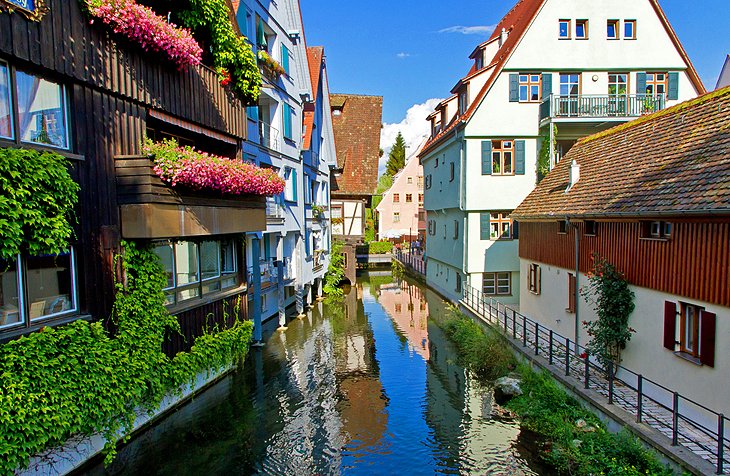
Set around the mouth of the River Blau, which flows into the Danube here, is where you'll find Ulm's very picturesque and skillfully restored Fischerviertel, the old Fishermen's and Tanners' Quarter. It's wonderful to explore on foot, and one of the favorite things to do in Ulm is to take a leisurely walking tour past its superbly restored half-timbered houses and stroll its inviting narrow alleyways and bridges.
A highlight of this fascinating area is the famous Crooked House (Das Schiefe Haus). This charming 14th-century timber-framed home is now a hotel (Hotel Schiefes Haus Ulm), but even if you're not staying here (it's a highly recommended experience), it's well worth seeing. Although much of its lean was corrected in 1620, it still leans over the river supported by its ancient beams.
The Fischerviertel area is also wonderful to explore at night when many of the old structures are lit up, and offers many excellent dining and shopping opportunities.
Address: Schwörhausgasse 6, Ulm, Germany
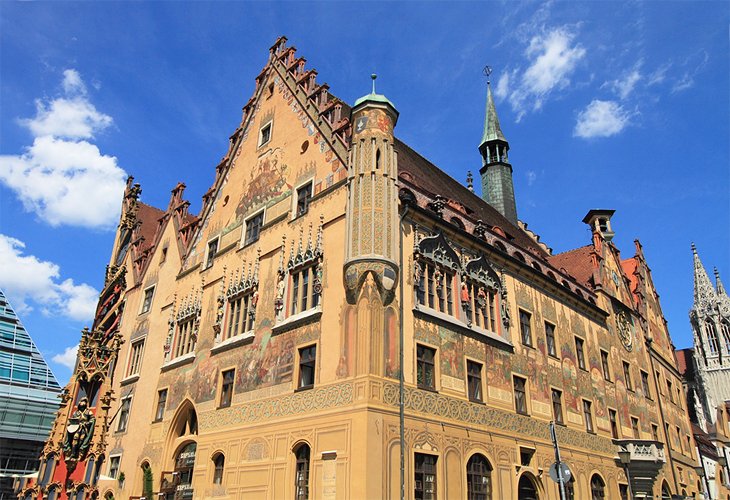
To the south of the Münster in the Marktplatz is the handsome Gothic Town Hall (Rathaus) with frescoes dating from 1540. With its architectural detail and frescoed Renaissance façade, there's no denying the building's visual appeal. Visitors are often surprised to learn that the intricate designs and décor were largely reconstructed after the devastation of World War II.
Originally built in the mid-14th-century, it first served as a form of medieval department store, housing a variety of different merchants and tradesmen, before becoming the town hall. Highlights of the building include a replica of the 16th-century astronomical clock , and the beautiful fountain known as the Fischkastenbrunnen (fish-tank fountain) built in 1482, which stands outside the building.
In startling contrast to this Renaissance building, beside it stands the modern glass pyramid of the Stadtbibliothek, the city library.
Address: Marktplatz 1, 89073 Ulm, Germany
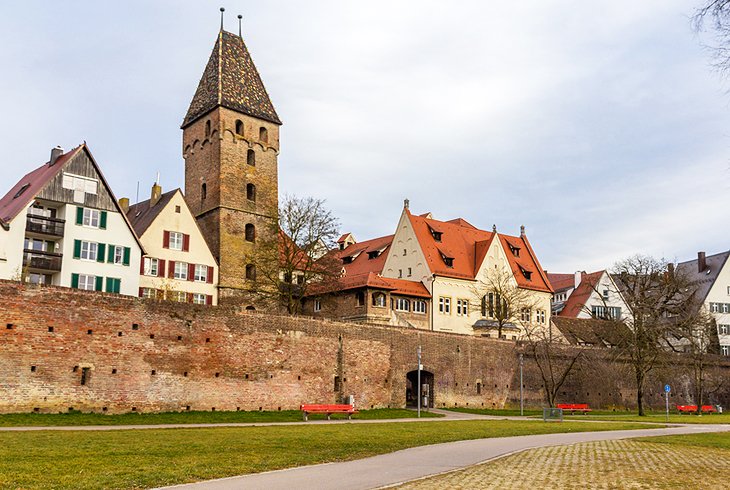
Most of Ulm's 15th-century town walls have been well preserved and provide an excellent means of exploring the old town. Built in 1482 along the banks of the Danube, the walls - originally designed as a deterrent against invaders - circle the town from the Lauseck Bastion, taking in the Fishermen's and Tanners' Quarters and the boat landing stages.
Along the way, you'll find the 36-meter-tall Metzgerturm , or Butchers' Tower, which leans several feet off the vertical. You'll also find many wonderful cafés and restaurants, as well as quiet riverside spots ideal for picnics.
One of Germany's finest collections of Upper Swabian art and culture resides in Museum Ulm. Highlights of its outstanding collections of art, archaeology, and history include the 40,000-year-old Lion Man, carved from mammoth ivory and the oldest known animal carving in the world.
Works by 20th-century artists including Klee, Picasso, and Lichtenstein are shown in the Kurt Fried Collection. Take a little time to also see the sculptures by Michel Erhart Joerg Syrlin the Elder and paintings by Martin Schaffner and Bartholomew Zeitblom.
Connected to the museum and worthy of a visit is the Archive of the Ulm School of Design. This popular gallery is well-known for its displays of artworks from the 50s and 60s.
Address: Marktplatz 9, Ulm, Germany
Official site: www.museumulm.de/en
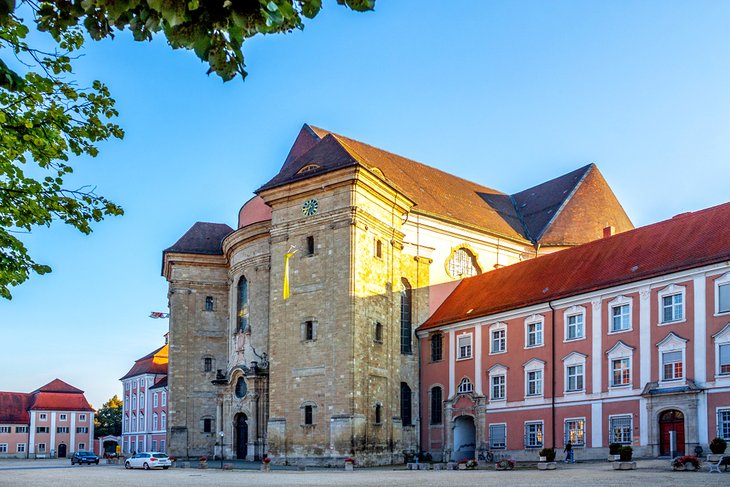
Located just five kilometers from Ulm is the large Benedictine monastery of Wiblingen . Founded in the 11th-century and dissolved in 1803, Wiblingen Abbey (Wiblingen Kloster) is home to a magnificent Baroque church built in 1780, with outstanding sculptures and ceiling paintings by Januarius Zick.
The monastery's highlight, though, is its sumptuously decorated Rococo library, one of the finest examples of that style. Its interior is ringed by a gallery set on highly ornamented columns, and combines with the statues and ceiling fresco for an airy and whimsical style that seems almost frivolous for a monastery.
Today, the building houses the Museum im Konventbau , which paints a fascinating picture of the role of the abbey over the centuries.
Address: Schlossstrasse 38, Ulm-Wiblingen, Germany
Official site: www.kloster-wiblingen.de/en/
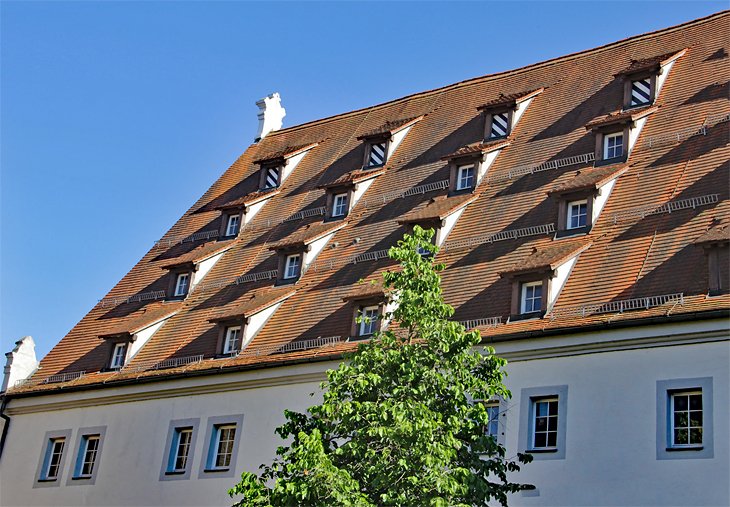
One of Ulm's most unusual places to visit, the unique Museum of Bread Culture (Museum Brot und Kunst) offers a fascinating insight into the history of bread and baking from ancient to modern times. Exhibits cover everything from the growing of grains and harvesting of crops, to the social implications of bread (or a lack thereof) upon populations, as well as its impact on art and culture.
The museum also houses an impressive art collection based upon these themes. It includes pieces from the Middle Ages to modern times by artists such as Rembrandt, Dalí, Picasso, and Man Ray. English language guided tours are available.
Address: Salzstadelgasse 10, 89073 Ulm, Germany
Official site: https://museumbrotundkunst.de/en
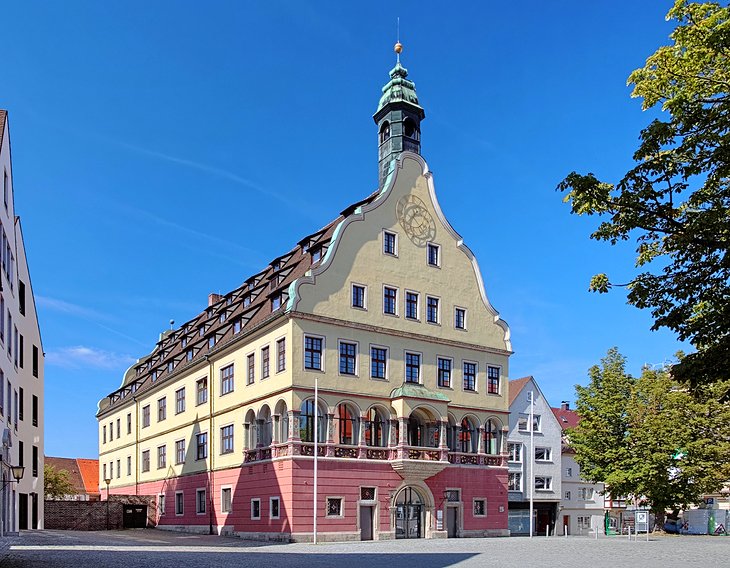
A highlight of Ulm's old town center is the wonderful Oath House, or Schwörhaus. Built on what was, in AD 854, the old Kings Palace, the existing 17th-century structure becomes the most important building in Ulm the first Monday of July. Known as Oath Monday, it's on this day that the city's Lord Mayor gives his account of the previous year's events.
What's remarkable is that this tradition has taken place every year since 1397, and the day is marked with celebrations and events. Also noteworthy here is the local history museum, which is located within the Oath House.
Another nearby tourist attraction that's worth a visit is the lovely Christopher Fountain dating from 1584.
Address: Weinhof 12, Ulm

For those traveling with children, one of the best places to visit is the delightful, though small, Tiergarten Ulm. Certainly no equal to the outstanding zoos in Leipzig or Munich, Ulm's Tiergarten has a respectable collection of exotic animals along with goats, deer, alpacas, and other animals. More exotic creatures live in the Tropical House, where you can see wallabies, Capuchin monkeys, Mississippi alligators, crocodiles, gibbons, and other warm climate species.
Children are especially fascinated by the aquatic displays, which include an 18-meter-long Danube Tunnel for cold water fish, and tropical fish swimming among coral and sea anemones. A nice park adjoins the zoo, with sculptures and playgrounds for children.
Address: Friedrichsau 40, Ulm, Germany
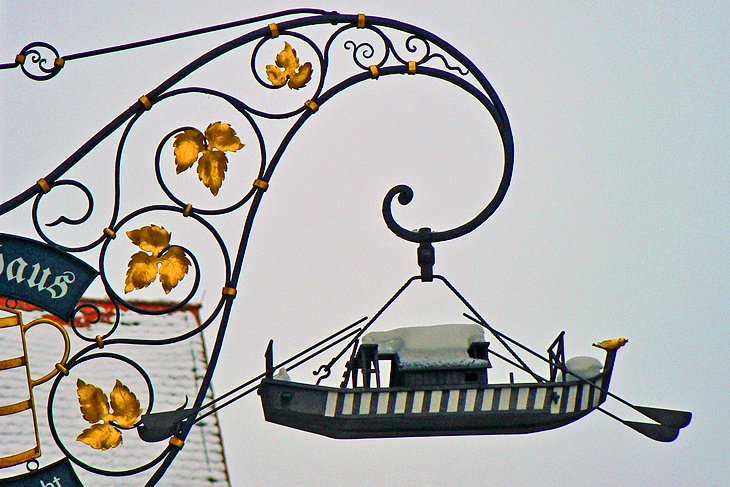
The Danube Swabian Museum (Donauschwäbisches Zentralmuseum) is well worth visiting for a better understanding of the regional history. Highlights include the Ulmer Schachtel (literally the "Ulm Box"), an 18th-century wooden boat used to transport emigrants down the Danube as far as Hungary.
Many of the museum's fascinating exhibits in fact focus on the story of these immigrants, who settled at various points along the Danube in the 17th and 18th centuries, showing the everyday life of those villages and towns between Budapest and Belgrade where the Danube Swabians settled.
The exhibits not only trace the lives of these Swabian people through a history marked by world wars and Iron Curtain repressions, but consider the current status of German minorities in Hungary, Romania, Serbia, and Croatia. Guided tours are available, and a gift shop is located on-site.
Address: Schillerstraße 1, Ulm, Germany
Official site: www.dzm-museum.de/en/
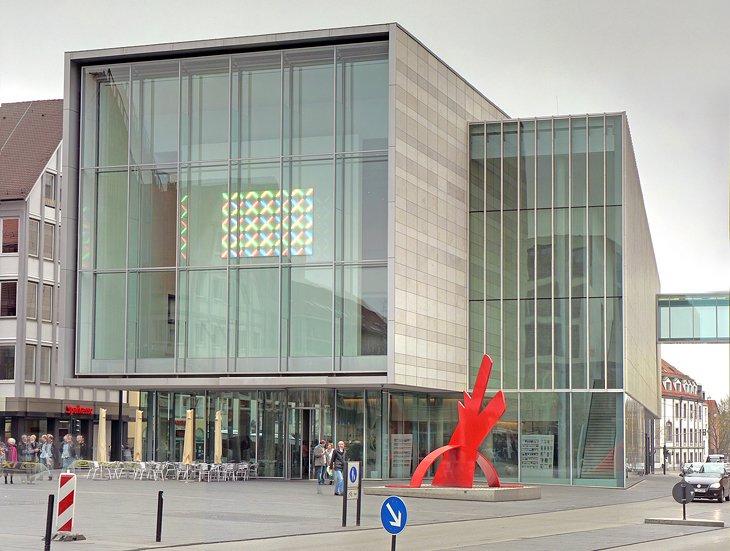
You can't miss this sleek modern building next to the more traditional architecture of the Ulm Museum - especially because in front of it stands the large red Dog sculpture by Keith Haring. Inside this must-see attraction are works selected (and rotated annually) by art collector Siegfried Weishaupt, representing 20th-century and modern art movements .
Included are works by Andy Warhol, Jean-Michel Basquiat, Mark Rothko, Josef Albers, Dan Flavin, Willem de Kooning, Kenny Scharf, Tony Cragg, Robert Longo, and others. Don't miss the great views of the cathedral spires from the balcony. Guided tours are available, and if you're feeling peckish, be sure to stop in at the on-site café.
Adress: Hans-und-Sophie-Scholl-Platz 1, Ulm, Germany
Official site: http://kunsthalle-weishaupt.de/en/
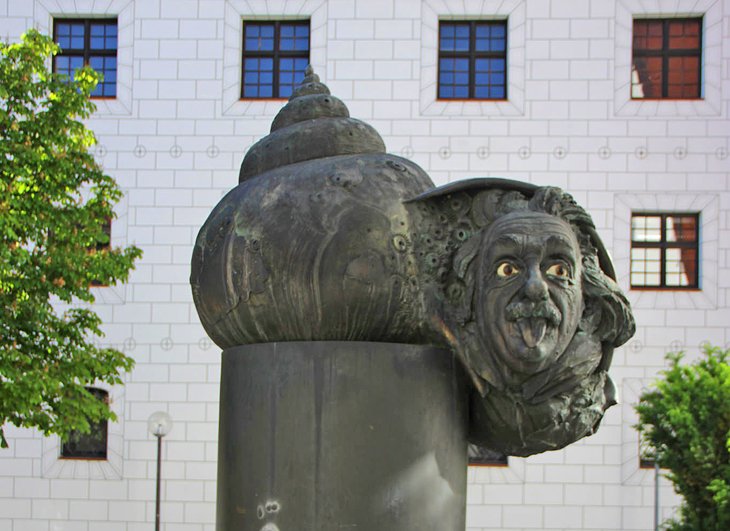
While fountains are a common sight in many European cities, as are monuments to famous native sons, none is more unusual that Ulm's Einstein Fountain (Einstein Brunnen). This unique cast bronze sculpture depicts a large snail (chosen to represent nature and wisdom) standing on a rocket (representing the scientist's studies in time, space, and atomic theory) that shoots water from its base.
Emerging from the snail is the head of Einstein in the famous pose with his tongue stuck out and hair in wild disarray. The fountain, which sits at the 16th-century Zeughaus arsenal, was created by Jürgen Goertz in 1984. Einstein was born in Ulm, but lived here only the first year of his life.
Address: Am Zeughaus 15, Ulm, Germany
More Related Articles on PlanetWare.com
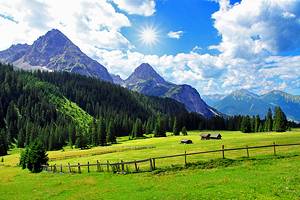
Places to Visit near Ulm: Ulm sits between Germany's popular Black Forest region of Baden-Württemberg, with its lively capital of Stuttgart to the west, and the many attractions of Bavaria to the east. To explore Bavaria's capital, see our handy page on the top tourist attractions in Munich.
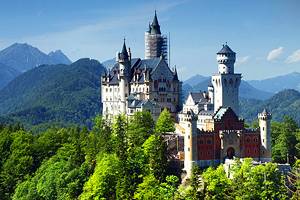
Where Else to Go in Germany: To the northwest in Baden-Württemberg, you'll find the attractions of Heidelberg and the beautiful spa city of Baden-Baden , at the edge of the Rhine Valley . Across the Rhine River in France, you can visit Strasbourg and discover the medieval towns and villages of Alsace .
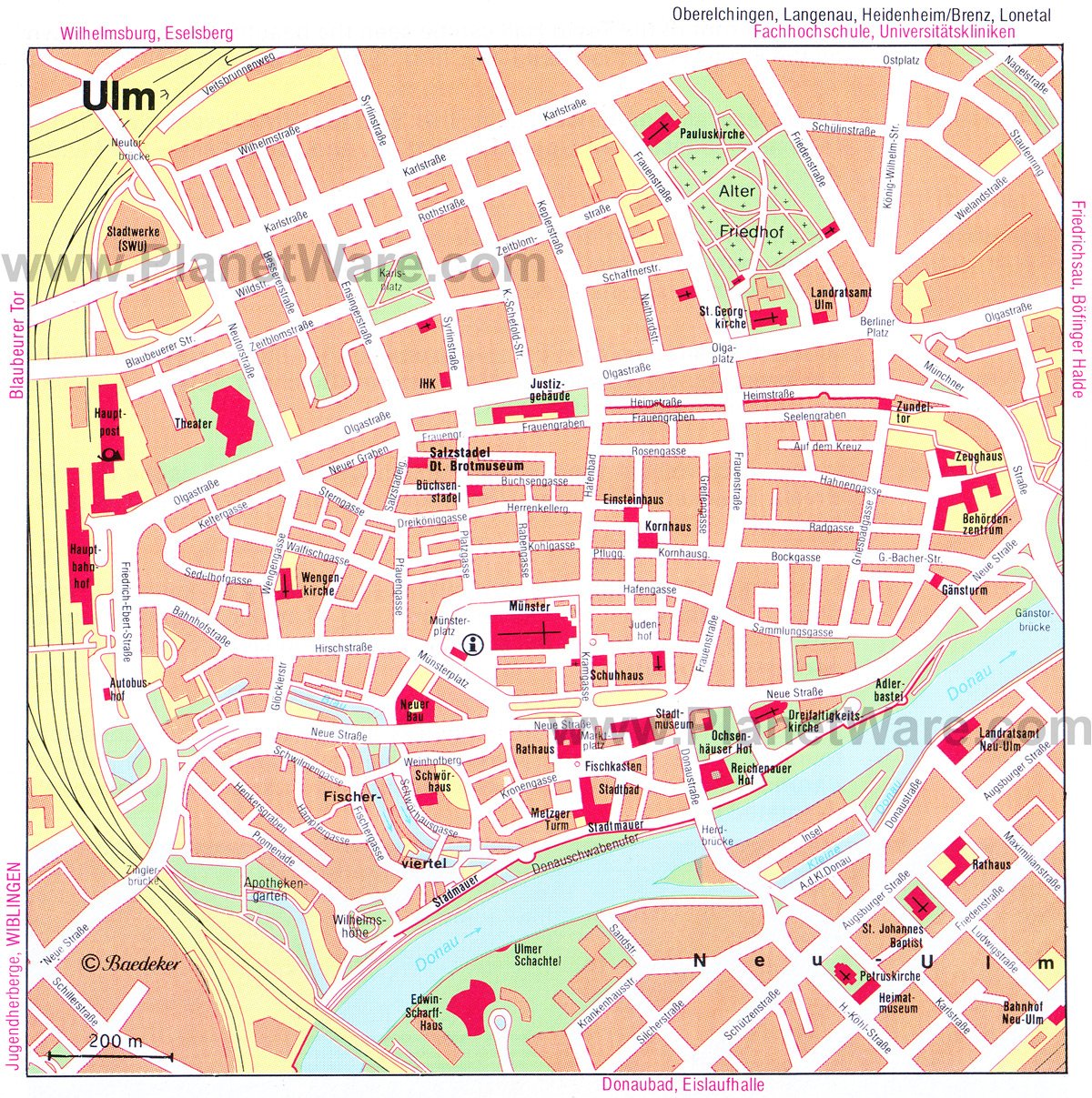
More on Germany
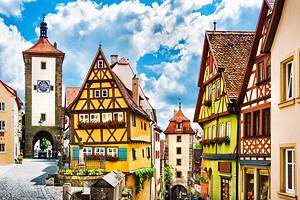
Privacy settings
Here you will find an overview of the types of cookies used on the website. You can set your consent for each category individually. Further information can be found in the privacy policy .
- Essential Cookies For the use of the website with all functions (e.g. user settings, watch lists, etc.)
- Statistics Statistics Cookies collect information anonymously. This information helps us to understand how our visitors use our website.
- Marketing In order to provide you with the best possible offer in cooperation with our partners, we use marketing tools. For example, in order to use our chatbot, you must activate this setting.
- External contents Required for viewing external media and third-party content. The provider may set cookies for its part. The respective data protection regulations of the provider apply.
- Inspiring Germany
Cities & Culture
- Nature & Outdoor Activities
- Royal Palaces & Castles
- Experience & Enjoy
- Current highlights
- Sustainable travel
- Barrier-free travel
- Easy language
- Federal states
Ulm: the ultimate combination of tradition and modernity
Ulm Minster has towered over the city for centuries. Following the widespread destruction of Ulm in World War II, locals struggled to find the right way to handle its reconstruction. A compromise was ultimately reached, which saw a unique cityscape of lovingly restored buildings on the one hand and breathtaking modernity on the other.
With the tallest church tower in the world, Ulm Minster is, of course, the city's most dominant building. And the Münsterplatz square on which it stands is an endlessly fascinating place that offers a great mix of history and pioneering architecture. But there is definitely more to Ulm than this. The former Free Imperial City boasts a variety of historical attractions, such as the Town Hall featuring elaborate paintings on its exterior walls, the Trading House, the ancient Stone House, the 17th-century Oath House and the Romanesque Chapel of St. Nicholas, which was built in around 1220.
Ulm Minster
Fischerviertel quarter, weishaupt gallery, stadthaus ulm, ulm town hall.
The old buildings stand in stark contrast to Ulm's modern structures with their remarkable architecture. Take, for example, the white Town House, the glass-fronted Central Library, the Cultural Hall, the synagogue or the Kaufhaus Münstertor shopping centre. Dotted in between are world-class museums and collections, plus various theatres, gardens and parks. A tour of Museum Ulm is also a thrilling experience. Its archaeological collection includes the Lion-man, the oldest zoomorphic sculpture in the world. The popular Fischerviertel and Gerberviertel districts have been perfectly restored and are home to wonderful places to eat, drink and enjoy the company of others. There are also many relaxing beer gardens in Neu-Ulm, the city's Bavarian counterpart on the other side of the Danube.
Discover more
This is the taste of germany, a paradise for cyclists: ten mountain biking hotspots, dine and sleep in regal style, shopping in germany: here's where it's at, science centres: learning through play, cities on the border: rubbing shoulders with european neighbours, explore the surroundings.

IMAGES
VIDEO
COMMENTS
Here are the best things to do in Ulm: 1. Ulm Minster. Source: Mikhail Markovskiy / Shutterstock.com. Ulm Minster. To set the scene, Ulm Minster has the highest steeple in the world, is officially the tallest complete church in the world and coming into the 20th century it was the 5th tallest man-made structure.
Danube Swabian Museum. Learn more. The museum is located in a historic building of the Ulm Federal Fortress, only a few metres from the banks of the Danube. Two tours show the history of the Danube Swabians (950 sqm) and the diversity of the Danube, the great European river (550 sqm). Exhibition "Danube Swabians.
Learn more about the best places to visit in this historic city, with our list of the top attractions and things to do in Ulm, Germany.
In addition to offering its visitors the view of the Ulm Minster, the highest church steeple in the world, Ulm also offers its visitors an enchanting view of the old town, the fishermans' quarter, and the Wiblingen monastery.
Things to Do in Ulm, Germany: See Tripadvisor's 23,824 traveler reviews and photos of Ulm tourist attractions. Find what to do today, this weekend, or in October. We have reviews of the best places to see in Ulm. Visit top-rated & must-see attractions.
Discover the beauty of contrasts in Ulm with the world's tallest church tower, history, good food and drink and modern architecture.